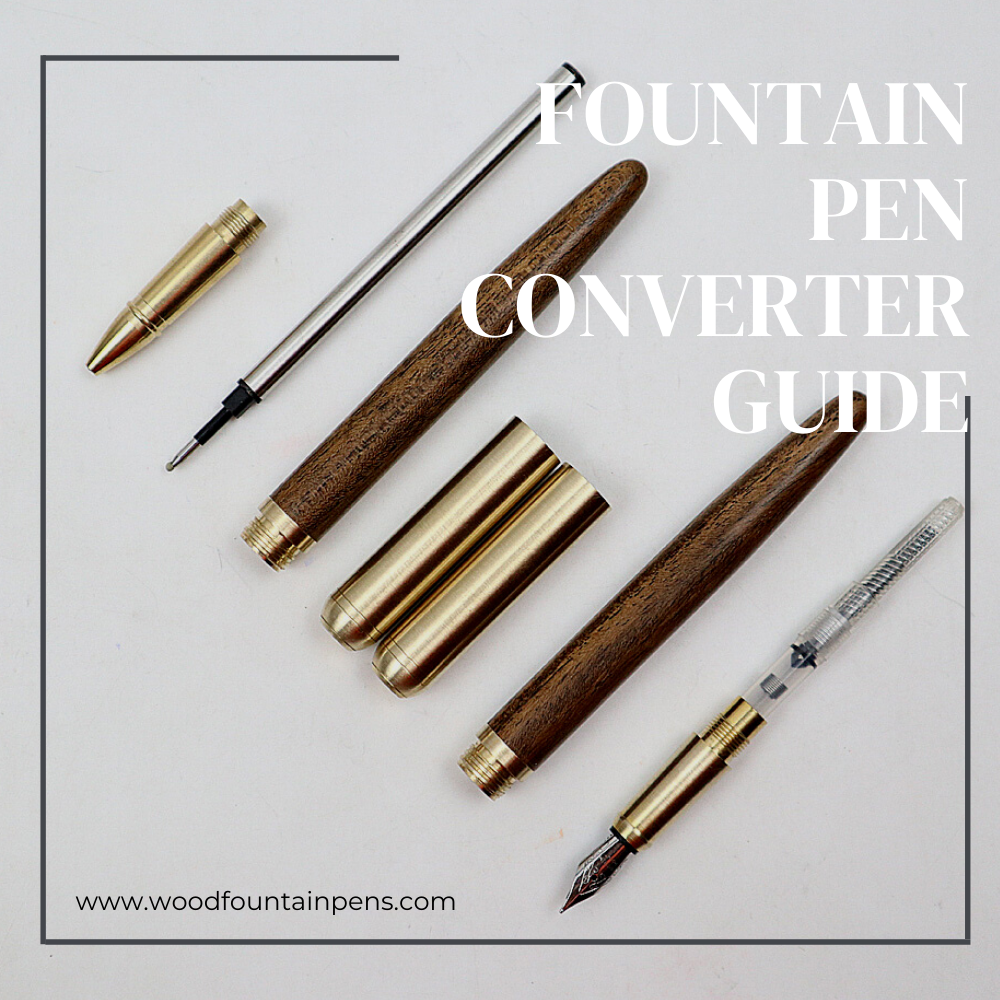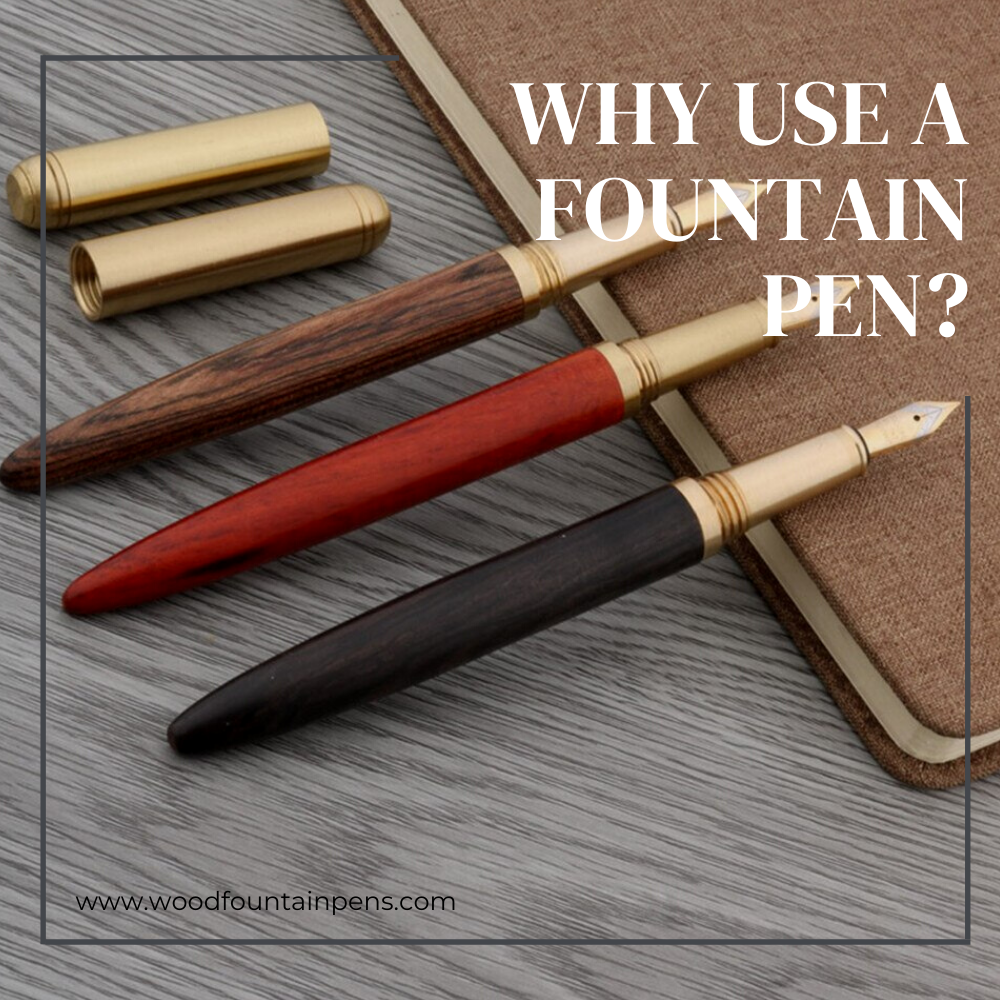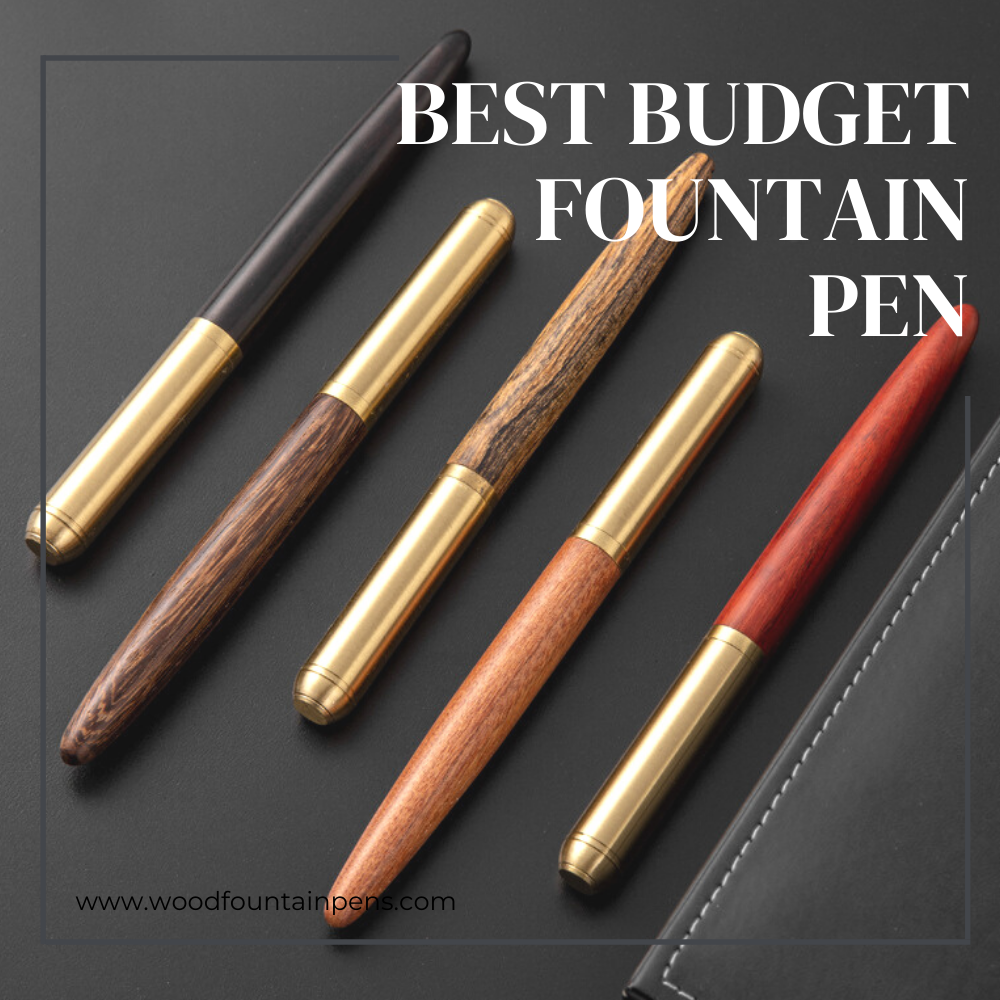
Fountain Pen Converter Guide
Fountain Pen Converter Guide
Welcome to the Fountain Pen Converter Guide! You're itching to try out a different bottle of ink for your favorite fountain pen? Well, here we go! Want to know which fountain pen brands use which types of converters?
Too often, when you're looking for an exact match, there just aren't any cartridges available at all. You don't need to switch out cartridges when using a converter; just plug in any cartridge from your collection into the converter and see which one works best for your current writing style.
Find out which converters fit different brands of pens here.
Note: Most fountain pen refills can be used in most international converter types. However, some models might require special converters. It’s not an absolute rule; just something to consider when buying one. For example, if you're using the 0.5mm nib size, please use an appropriate converter size.

What is a Fountain Pen Ink Converter?
On this Converter Guide, you will know What a Fountain Penk Ink Converter. A fountain pen converter makes it easier for you to use a fountain pen by allowing you to refill its ink reservoir from bottles rather than using an ink cartridge. Converting fountain pens into cartridges allows you to use any brand of cartridge regardless of which brand of fountain pen you own. It also lets you change color easily if you want to experiment. If you're using an ink cartridge from another manufacturer than the ones offered by your fountain pen, then buying additional cartridges for use when out and about could be expensive.
A fountain pen refiller is a tool used for converting bottled ink into an equivalent quantity of ink suitable for use with a fountain pen. Refilling pen cartridges from bottled ink is an excellent choice for people who want to switch colors without having to replace the entire cartridge.

What types of Fountain Pen ink converters are there?
Different kinds of fountain pen ink converters may be used for similar purposes but differently. On this Fountain Pen Converter Guide, Here’s an overview of the different types of ink converters available.
Piston converter
Most commonly used by printers, a piston ink converter converts printer cartridges into an inkjet cartridge compatible with a laser It works by using an electric current generated from a battery to turn a dial into a different position. When you push the button at the top of the cartridge, it creates a vacuum that pulls ink from inside the cartridge up through tiny channels and then out onto the paper.
Squeeze converter
Squeezers are older in design than pistons and are fairly easy to operate. When squeezing the air out and letting go at the end of each stroke, you create a vacuum that pulls ink up from the reservoir and delivers it onto paper.
Push-button converter
It’s not uncommon for people who use fountain pens to switch to using ballpoint pens because they don't like the feel of writing with a pen nib. They're not always easy to use but they offer better accuracy and cleaner results than most other converters.
How to use fountain pen ink converters
Fountain pens were initially created due to people becoming increasingly annoyed at the inconvenience of having to dip a pen to refill the ink repeatedly.
Over time, the fountain pen has become a lavish piece of writing equipment that has a smooth flow and allows writers to experiment with different colors of ink and styles of handwriting through nib size.
fountain pens use liquid ink, it is argued that you will likely have fewer issues with hand fatigue and cramping than with a ballpoint pen as you do not have to press down to write. While fountain pens offer a luxurious writing experience, they do require some maintenance, for example, the changing of an ink cartridge or the refilling of an ink converter.
On this Fountain Pen Converter Guide, We've compiled some information below about using fountain pen ink converters, for those of you who are new to them.

How to Use an Ink Converter (Fountain Pen Converter Guide)
Converters are like a piston and they push in or screw into position. Follow these steps to help you use your fountain pen ink converter:
1) Place the tip of the fountain pen into an inkwell.
2) When drawing the piston back completely, draw the ink chamber too.
3) Fill the entire surface of the converter with ink by repeating the filling operation until no more ink remains inside the cartridge
4) To get two-thirds of the ink out of the bottle, let one drop of ink back into the container to create an air space between the surface of the liquid and the inside
5) Be careful when using an overfull converter because they may leak if heated up by body heat.
Although there are different types of ink converters, they all work in very similar ways. Below are step-by-step instructions on how to use any ink converter.
1) Take apart your fountain pen. Unscrew the top from the body of the bottle.
2) Insert the selected converter into your pen’s grip section.
3) Put the pen down and dip the tip of the nib into the bottle of ink. Make sure the entire nib is submerged in ink before putting the pen back down again.
Depending on which type of converter you have, this step may vary slightly.
a) When using the pump mechanism, turn the knob clockwise until the ink cartridge stops printing. It may take several turns for the ink cartridge to stop printing. Turn the crank the other way to lower the piston and expel the air from the cylinder. Then turn the dial back to its original position and
b) Squeezing the bag or sack quickly may cause air bubbles to form inside the mixture. To avoid them, gently squeeze the bag or sack until mixed well before using it. Repeatingly, and then vacuuming up the ink, will create a vacuum that draws the ink into the converter; thus creating an image.
c) Tap the touch screen once for each letter. Repeating these steps, the ink will eventually come out of the converter.
If there’s too much ink left on the nib after using it, wipe off the nib on a piece of paper towel so that there are no excess ink.
Reassemble your pen.
How to replace a cartridge (Fountain Pen Converter Guide)
First off, remove the nib cap (the part at the end) of the pen. Then, take out the old ink cartridge. To remove an empty cartridge from its holder, follow these steps:
To insert the new cartridge, place its narrow end into the nib’s housing.
When you press down on the cartridge, you'll hear a click. This is the sound made by the writing block when it pierces the cartridge's protective seal.
Wait until the ink begins flowing through the nib before beginning writing;
Reassemble the pen.
After completing the above steps, the fountain pen should start writing almost instantly. If not, hold the pen horizontally so that gravity draws ink into the tip from above. Writing takes time. Don't worry if it doesn't happen right away.

Filling a piston pen (Fountain Pen Converter Guide)
After having replaced our fountain pen ink cartridge and filled a converter pen, let’s now take a closer look at piston-fills.
Piston mechanisms use a spring to push ink into an internal chamber where it stays until released by pressing down on the nib. Most mid-range or high-end Montegrappa fountain pens typically use a patented, ratcheting piston fill system. To get started, here are the steps needed to use it:
Turn the cap anti-clockwise until it stops.
Dip the entire pen tip into the ink bottle.
Twist the cap counterclockwise until it starts moving again.
Take out the pen cap from the ink cartridge.
Twist the cap until there’s just enough space for the tip of the pen to fit through; let some ink dribble out to release any trapped air bubbles.
Use a clean, damp, lint-free cloth to wipe down the nib.
Filling a converter pen (Fountain Pen Converter Guide)
To fill an ink converter pen with a blasure system, first dip the nib into the bottle and then follow these steps:
If you gently press down on the backside of the nib (the part where the ink comes out), bubbles will appear at the tip of the nib.
As slowly as possible, let go of the pen cap and allow the ink to flow back down through the nib.
Fill up the entire container by repeating the above steps.
To use a pen with a piston converter, first, turn the knob at the bottom of the converter counterclockwise until there’s no resistance when turning the knob; then rotate the knob at the top clockwise until there’s no resistance.
Good fountain pen maintenance
When using a fountain pen, some basic cleaning techniques include wiping down the nib (the part where ink comes out) with rubbing alcohol or an old toothbrush dipped into water. If you're using a fountain pen frequently enough to ensure that its ink has been fully consumed at least once every 6 months, then you'll be fine. If your ink consumption slows down, stop using new cartridges for at least 24 hours so that they can be recharged by sitting idle overnight. Then, if necessary, replace them with fresh
For occasional users who don’t want to spend too much time cleaning their pens, consider buying an inexpensive pen refill kit so they can just buy new refills when needed. Don't use detergents or solvent cleaners for cleaning pens.
Conventional blue ink contains more solids than colored inks. People who use colored ink need to clean their fountain pen more often than people using black ink.
Good maintenance leads to good things
It’s important not to leave your fountain pens uncapped because they could leak ink onto clothing or furniture. Exposing pens to air helps liquids evaporate faster, allowing solids to collect inside the pen sooner than they would otherwise.
Ink becomes thicker due to evaporation from the surface of the paper and accumulates in the capillary grooves of the paper, which causes the printing mechanism to become blocked. If either issue occurs, then your fountain pen may be unable to write properly.
In fact, even when using inkjet printers, there are some things you need to know before buying an ink cartridge for them. You shouldn't purchase too much of either product at once; instead, take advantage of them for up to 18 months before replacing them.
It’s important to care for a Montegrappa Fountain Pen so that its performance remains consistent. Refillable fountain pens require regular cleaning and filling. Practice helps ensure success when using them. Many seasoned pen enthusiasts enjoy recharging their beloved fountain pens by filling them up again. It’s an enjoyable experience that they look forward to every time.
We hope that you have learned something in this Fountain Pen Converter Guide!
Fountain Pen Converter Guide FAQs
How do I replace an old ink cartridge for a new one?
To remove an ink cartridge from a fountain pen, first place the tip of the barrel onto the top edge of the cartridge holder (the part where the cartridges slide in). Then press down firmly on the cartridge so that it snaps out of its slot.
How Do I Refill a Fountain Pen?
How you do it depends on the type of pen you own.
What is the best way to refill a fountain pen?
Cartridge pens are by far the most common type and are the simplest to refill.
What are piston-fill pens?
Like converter pens, piston-fill pens are refilled directly from a bottle and require no ink cartridges.
How do I fill a converter pen?
Practical and fast method For filling a converter pen with a bladder system, dip the nib into the ink bottle and follow these steps: Gently depress the knob on the rear of the pen until bubbles form on the surface of the ink Slowly release the knob and wait for the ink to be drawn up into the bladder.
How do I clean my fountain pen?
Never use detergents or solvents to clean your pen.
What are the benefits of fountain pens?
Most seasoned users consider refilling fountain pens a pleasurable ritual, another way for connoisseurs to savor their beauty and timeless technology.
What are the problems with fountain pens?
Exposure to air allows fluids to evaporate more quickly, increasing the rate at which solid residues can accumulate within the pen.
What is the best fountain pen maintenance?
Fountain pen maintenance and refilling can be daunting for first-time users, but practice makes perfect.
What are piston-fill pens?
Fountain pens made with a piston mechanism have a reservoir concealed inside the barrel.
How do I use the pen?
Filling the tank Now that we have learned how to replace fountain pen ink cartridges and fill a converter pen, let's take a look at piston-fill pens.
How do I clean the nib?
Here are the steps required to operate it: Twist the blind cap anticlockwise until it stops; Dip the entire nib into the ink bottle; Draw ink into the pen by twisting the blind cap clockwise until it stops; Remove the nib from the ink bottle; Twist the blind cap half a turn anticlockwise, letting a little ink drip out to release air; Clean the nib with a damp, lint-free cloth.







Leave a comment
This site is protected by hCaptcha and the hCaptcha Privacy Policy and Terms of Service apply.